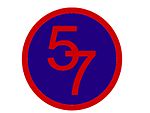No. 57 Squadron RAF
| No. 57 Squadron RAF | |
|---|---|

57 Squadron badge
|
|
| Active | 8 June 1916 – 31 December 1919 20 October 1931 - 9 December 1957 1 January 1959 - 30 June 1986 1 July 1992 - 14 March 2002 1 October 2008 – ? |
| Country |
|
| Branch |
|
| Motto(s) |
Latin: Corpus non animum muto ("I change my body not my spirit") |
| Battle honours | Western Front, 1916–1918: Amiens, France & Low Countries, 1939–1940: Norway, 1940: Channel & North Sea, 1940: Ruhr, 1941–1943: Fortress Europe, 1941–1944: Berlin, 1941–1943: Walcheren, France & Germany, 1944–1945: South Atlantic 1982. |
| Insignia | |
| Squadron Badge heraldry | Issuant from two logs fesse-wise in saltire a phoenix. The badge commemorates the fact that during the First World War, on one occasion the whole of the flying personnel became casualties within a few days, but the squadron remained in action with new personnel. |
| Post 1950 squadron roundel | |
| Squadron Codes |
EQ (Nov 1938 – Sep 1939) DX (Apr 1940 – Apr 1951) QT (1944 – Nov 1945, 'C' Flt) |
No. 57 (Reserve) Squadron RAF is a Royal Air Force flying training squadron.
57 Squadron of the Royal Flying Corps was formed from on 8 June 1916 at Copmanthorpe, Yorkshire when it was split off from 33 Squadron, taking on its parent unit's part-time training role to allow 33 Squadron to concentrate on its main duties as a night fighter unit. No. 57 Squadron continued in its training role, equipped with a mixture of Avro 504s and Royal Aircraft Factory B.E.2s, until October that year, when it began to prepare for its planned role as a fighter-reconnaissance squadron, receiving Royal Aircraft Factory F.E.2d two-seat pusher biplanes in November.
On 16 December 1916 the squadron arrived at St. André-aux-Bois in France, moving to Fienvillers on 22 January 1917. By April 1917 the F.E.2d was obsolete, and the squadron suffered heavy losses supporting the British offensive at Arras. Examples included the loss of five F.E.2s in combat with a formation of German two-seaters on 6 April and the shooting down of three F.E.2s from a formation of seven by a group of 20 German fighters. The squadron re-equipped with more modern Airco DH4s in May 1917, changing role to long-range bomber-reconnaissance. After training on the new type, the squadron commenced operations near Ypres in June of that year, moving to Droglandt on 12 June and Boisdinghem on 27 June. The squadron joined the 27th Wing, part of the Fifth RFC Brigade, to support the British Army at the Ypres Offensive. The squadron's activities included bombing railway junctions and German airfields during the Battle of Langemarck in August 1917 and reconnaissance duties during the Battle of the Menin Road Ridge in September.
...
Wikipedia
